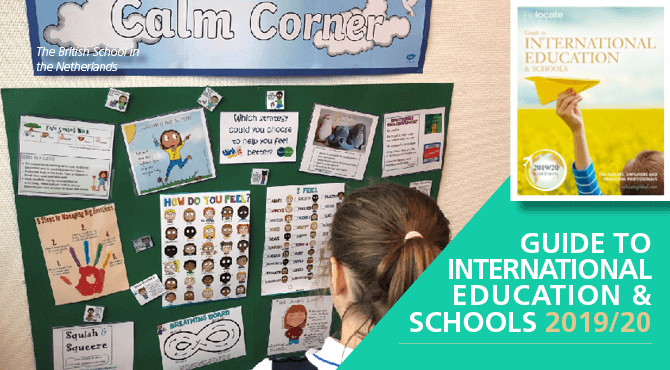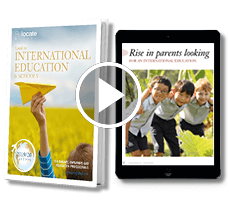Mental health in children: Is your school fostering a sense of wellbeing and promoting good mental health in children?
What strategies have been used at the British School in the Netherlands to successfully tackle the mental health issues faced by their pupils at the school?
Positive self-esteem is crucial
Our aim has been to ensure that mental health and wellbeing awareness and strategies become integral within the school day, rather than bolt-on activities. We began to achieve this by changing the timetable to ensure a calm start, middle and end to each day, which has given teachers more flexibility to manage the pace of the day and prioritise talking to students about their daily lives, alongside teaching lessons. We have also focused on positive self-esteem by developing a stronger sense of community through student leadership and opportunities to feel pride in being a role model for others. This includes a Responsible Citizen Award, created to encourage feelings of self-worth in doing things for others in the community.We’ve appointed a Curriculum Leader for Mental Health and Wellbeing – to raise the status as an important area amongst core subjects. We’ve also introduced fun initiatives like the ‘Daily K’ (kilometre), which has so many benefits and a high impact in term of enabling children to refocus between lessons.Hot Chocolate Breathing
These changes have made it possible to focus on wellbeing and mental health within the classroom. Students are taught specific tools and strategies for managing their mental health. Sessions have included learning to identify and name emotions; understanding the impact of positive self-talk; using a variety of breathing techniques (including Hot Chocolate Breathing, which has been particularly popular!) and choosing what works well for each individual; recognising how your body feels physically if you are struggling; and identifying which ‘Brain Break’ works best for individuals and specific situations.
Spreading the love
Having learnt a great deal, and seen their positive impact, we have begun to share these strategies across the school. The creation of a ‘Wellbeing Team’ was vital to support this process. We held meetings with staff and parents to share our work. ‘Calm Corners’, which provide a calm and safe space for children, have begun to pop up all over the school; and it’s a delight to hear teachers, parents and students share the strategies they are using.Investing in the future
This is just the beginning of a long journey. Next year all of our classes will have a Calm Corner; each phase will teach wellbeing tools; and two year groups will follow a Wellbeing Programme, including on areas such as managing emotions or coping with change (e.g. being ‘Third Culture’ children, or transition) – and students will be taught to coach one another on their wellbeing goals.It’s crucial to underline that prioritising wellbeing is not ‘a waste of valuable curriculum time’. Students who develop these skills are more able to learn and to cope with the challenges they face. Even more importantly, they are learning life skills that will help them throughout their lives. As adults, one in four of them will face mental illness. Yet every single one of them has mental health. We, as educators, have a responsibility to teach them how to take care of it. Karren van Zoest, is Headteacher of the Junior School Leidschenveen and Rhiannon Phillips-Bianco is a class teacher and the school’s Mental Health and Wellbeing Curriculum Leader at the British School in the Netherlands. This article is from Relocate Global's Guide to International Education & Schools 2019/20 which is packed with expert tips and information for those relocating and the professionals supporting them. For volume options, co-branded editions, digital or online licence agreements and advertising opportunities, contact Fiona Murchie at +44 (0)1892 891334 or email fiona@relocatemagazine.comNow available as an ebook on Amazon! Simply download from Amazon onto your Kindle, mobile phone or tablet to read wherever you are!
Subscribe to Relocate Extra, our monthly newsletter, to get all the latest international assignments and global mobility news.Relocate’s new Global Mobility Toolkit provides free information, practical advice and support for HR, global mobility managers and global teams operating overseas.
 Access hundreds of global services and suppliers in our Online Directory
Access hundreds of global services and suppliers in our Online Directory For more education and school-related news, visit our Education and Schools pages.© 2019. This article first appeared in the 2019/20 edition of the Guide to International Education & Schools published by Relocate Global, Spray Hill, Hastings Road, Lamberhurst, Kent TN3 8JB. All rights reserved. This publication (or any part thereof) may not be reproduced in any form without the prior written permission of Relocate Global. Relocate Global accepts no liability for the accuracy of the contents or any opinions expressed herein.
For more education and school-related news, visit our Education and Schools pages.© 2019. This article first appeared in the 2019/20 edition of the Guide to International Education & Schools published by Relocate Global, Spray Hill, Hastings Road, Lamberhurst, Kent TN3 8JB. All rights reserved. This publication (or any part thereof) may not be reproduced in any form without the prior written permission of Relocate Global. Relocate Global accepts no liability for the accuracy of the contents or any opinions expressed herein.©2025 Re:locate magazine, published by Profile Locations, Spray Hill, Hastings Road, Lamberhurst, Kent TN3 8JB. All rights reserved. This publication (or any part thereof) may not be reproduced in any form without the prior written permission of Profile Locations. Profile Locations accepts no liability for the accuracy of the contents or any opinions expressed herein.




































